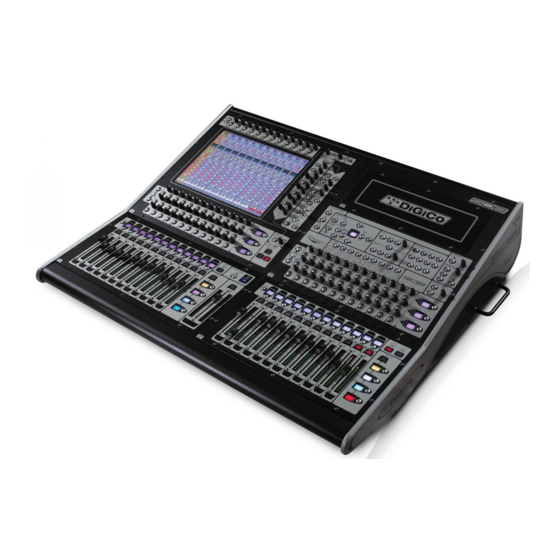digico SD10 Посібник користувача - Сторінка 14
Переглянути онлайн або завантажити pdf Посібник користувача для Обладнання для запису digico SD10. digico SD10 20 сторінок. Replacing and cleaning faders
Також для digico SD10: Посібник (9 сторінок)

Chapter 1 - Getting Started
1.3.3 Layers and Banks .................................................................
The SD10's worksurface is divided into Layers and Banks. Each Bank contains twelve channels, and the channels which are
currently active on the control surface are defined using the fader bank and bank layer buttons to the right of the Channel Strip
section's faders:
A 'bank' is a set of twelve faders, and a 'layer' contains up to four 'banks'. There are two 'layers' in each section of the desk,
allowing up to 144 channels to be accessible on the worksurface.
Pressing the bank layer button, located above the fader bank buttons, toggles between layers.
To access a bank of faders within that layer, press the appropriate fader bank button. To switch all three sections of the
console to the same bank level, press and hold one of the fader bank buttons.
The position of the banks on the worksurface is defined in the Layout > Fader Banks panel. By default, the Input channels will
be assigned to Layer 1 on the left and right sections of the console. The different output channels will be assigned to Layer 1 on
centre section. Control Groups will also be assigned to the centre section. These bank assignments can be customised by the
user and saved in a session at any time.
1.3.4 Using the Control Surface ....................................................
There are two main ways in which all of the functions of the SD10 are accessed:
1. The touchscreen display, which can be controlled directly using a finger, or by using the keyboard and mouse
2. The physical encoders, switches and faders.
Note that when touching the screen directly, you may find it easier to use a finer point than your finger.
However, in order to prevent damage to the screen, it is important that you only use devices specifically
designed for touching screens (such as a pda stylus), and that you never press down hard on the screen.
A number of functions can be accessed in different ways, allowing users to operate the console using whichever interface they
prefer. This manual will describe accessing on-screen functions by touching the screen directly and not by using the mouse.
All of the physical controls found in the centre section are described in full within the relevant section of the manual and many
require no further introduction. The Master screen has a row of grey buttons which are used to access a range of configuration
displays. Pressing these buttons opens either a further drop-down sub-menu or a pop-up display. If a drop-down menu is
opened, pressing on one of its entries will open a pop-up display. The buttons lighten to indicate that their sub-menu or pop-up
display is open. A number of the buttons within each pop-up display generate further pop-ups.
The buttons within the pop-ups are coloured grey when their function is inactive, generally switching to a lighter shade of the
pop-up background when their function is active. Pressing on a text box opens a numeric or QWERTY keypad which can be
operated directly by pressing the screen or via the console's external keyboard.
Pop-ups are closed by pressing the box in the top right-hand corner of the pop-up, marked CLOSE or CANCEL (or by pressing
CAN on keypad pop-ups).
To the right and below the Master screen is a single encoder marked touch-n-turn (shown below). This is used to access some
of the rotary and switch controls within the Master screen. To assign the touch-n-turn encoder to a particular on-screen pot,
touch the pot to be assigned. You will notice that a coloured ring appears around the on-screen pot, indicating that it is assigned
to the touch-n-turn encoder/switch.
1-6
Select a Layer
Select a Bank
